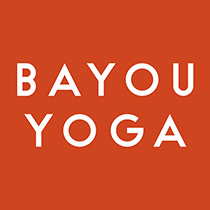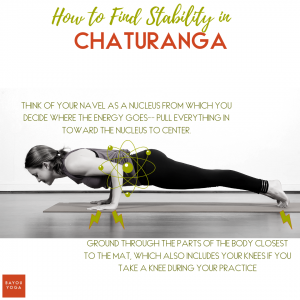How to Build Stability in Your Yoga Practice

We talk a lot about stabilizing our bodies when we are on the mats. But, what do your instructors really mean? Here’s a few ways that stability can surface in your practice.
In static poses, if you’re wobbly, you may feel instable like your about to topple over or fall out of the pose any minute. One of the keys to finding stability here, is to ground yourself. By grounding yourself, you bring your awareness to the part of the body that is closest to the ground, which creates a better foundation and allows control of the body. The source of stabilization in this circumstance comes from the ground, thus, the nature of this type of stabilization is grounding. Listen for cues like “ground down, press away, root, etc.” and you’ll know to bring your attention to the parts of the body that is closest to the earth. Observe how secure you feel when you engage your body in this matter.
When we are moving, our source of stabilization tends to come from a different source. Generally, you’ll want focus on the core of the body—either starting at the hips, the abdomen, or the rib cage. When you are mindful of engagement in this section of the body, you have more control over your movement because that part of the body stabilizes even though it is moving and potentially crossing the different planes of your body. In this situation, stability radiates from the center of your body, and is often classified as centering the body.
Now, let’s think about how this shows up in practice.
In Mountain pose, you are standing on two feet. When the instructor tells you to ground, you press evenly through the four corners of the feet. Here, your stability comes from grounding. If you add centering, then the pose becomes even more dynamic as your point your hips forward, tone the abdomen and slide the shoulders down the back as you lengthen from root to crown.
In Warrior 1, the concept is the same. But here, the opportunity to stabilize comes from additional sources. For example, not only are you standing on two feet where you are your most stable, but you have the opportunity to occupy a significant amount of space on your mat, thus increasing the size of your foundation and the energetic strength you can absorb from a wider stance. As you get more comfortable in this position, you can make the stance more narrow, requiring the ankles and the feet to work together. The more force you exert from your feet, the more active the ankles become, which makes the pose even more stable.
In both static and moving poses, there are additional techniques that you can use to create an even greater sense of stability. Using sensation in the part of the body that is closest to the ground allows you to sense instability. It picks up on subtle shifts in energy that could potentially make an impactful change on the body’s stability. Time is of the essence when you rely upon sensation to increase stability. The moment that the feet (or other body part connected to the ground) detects a shift in energy, is the moment that the practitioner should respond with activation and/or adjustment if necessary.
Another tool to help stabilize is drishti… or line of sight. If you’re feeling particularly wonky, you may want to employ one of two points of view. Either looking directly down or to the horizon, which is at the end of the soft gaze directly in front of you. By taking in the space between you and the horizon, you have an opportunity to appreciate any potential obstacles or triggers. It allows the balance to be maintained even in the face of adversity.
Finally, pay attention to the tension in your body. Notice when you feel pressure changes, that usually means that you are moving away from balance. The idea is to create a natural tension of muscle engagement and awareness so that you can experience changes in movement or balance and to give us an extra tool to manage and control our stability despite the circumstances under which we practice.
Next time you’re on the mat, try some of these tips. Ground and center the body. Notice that you can create stability when you are moving. Now imagine how this shows up in life off the mat.


